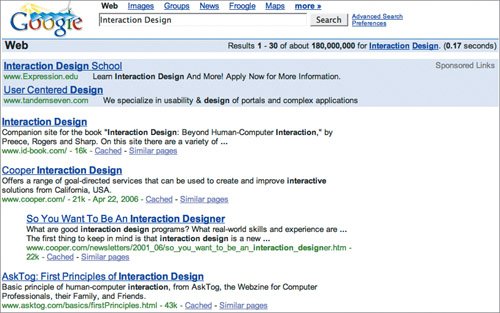Characteristics of Good Interaction Design
| In almost all designs, no matter for what, digital or analog, interaction designers should strive to reflect the following set of adjectives. Certainly in some circumstances, some of these characteristics may not be appropriateyou may not want a mission control panel to be playful, for examplebut in general, if a product or service can be described with these adjectives, it is likely an example of good interaction design. TrustworthyBefore we'll use a tool, we have to trust that it can do the job. You wouldn't pick up a rusty hammer with a loose handle to drive in nailsyou wouldn't trust it to not smash your thumb. The same holds true for digital products and for services. Given a choice, you wouldn't eat in a filthy restaurant or use a mobile phone that only occasionally rang when someone called. Humans likely make decisions about the trustworthiness of a product or service within seconds of engaging with it. Indeed, recent research has suggested that humans make snap judgments in less than a second. Products and services have to display their trustworthiness quickly. They need to appear like they aren't going to rip us off, injure us, sell our personal data, break immediately, or otherwise betray our trust in them. If we trust something, we are much more likely to deeply engage with it and perhaps even take measured risks with it. Would you rather walk across a sturdy steel bridge or a rotting, swaying rope one? A trustworthy product or service is one that users will take the time to examine and learn, discovering and using more features because they aren't afraid that something bad will happen to them if they do. AppropriateThe solutions that interaction designers come up with need to be appropriate to the culture, situation, and context that they live in. All of these factors can drastically affect the type of product or service that a designer makes (Figure 3.8). Figure 3.8. The henna decoration of this girl's hand could provide valuable insights for designers of products for India.
iStockphoto The Japanese and Koreans are famously advanced mobile phone users and can use expert features that would boggle Americans. In France, cooking and eating are social events best enjoyed slowly, and even simple meals are prepared with care; American-style fast food services have only grudgingly gained acceptance there after many years of struggle. Certain colors have different meanings in different culturesfor instance, white in China and Japan denotes mourning, whereas in Europe and America it denotes purity and cleanliness. Dutch cultural anthropologist Geert Hofstede, in his book Software of the Mind, identified five major dimensions that can be used to help understand different cultures and adjust designs accordingly:
Where a culture places on these continuums can greatly affect design. For example, a culture that places a high value on uncertainty avoidance may prefer simple, limited choices in a product rather than many, complex ones. An understanding of the specific situation that a product or service will work in, and also the emotional context of that situation, are essential to good design. Airport check-in kiosks (Figure 3.9) can't be complicated or require any significant learning to use themthey are used infrequently by harried people. Likewise, you wouldn't design a toy for young children the same way you would design a military communication device to be used in battlefield conditions. The situation dictates a set of constraintstechnical, cultural, and emotionalthat designers ignore at their peril. Figure 3.9. An airport check-in kiosk like this one cannot be too complicated. It needs to take into account its context (a busy place) and the user's state of mind at the time of use (probably harried).
SmartThe products and services we use need to be smarter than we are. They have to prevent us from making mistakes or from working harder than we need to. They need to do for us humans the things we have trouble doingrapidly perform computations, infallibly remember things over both the long and short term, and detect complicated patterns. They need to do the work we can't easily do alone. They have to be smart. As noted earlier, Tesler's Law tells us that all processes have a core of complexity that cannot be overcome, only moved to different places. While taking care to not remove important skills from people, a good design moves as much complexity as possible into the services we use and the products we own, where it can be handled more effectively. Your mobile phone can hold far more phone numbers than you could ever memorize. Calling 911 will get the proper emergency services to your house more quickly than will looking up and then dialing the individual phone numbers. A Google search (Figure 3.10) will find obscure pieces of data more efficiently than will manually browsing because the Web service has taken on the complexity of browsing millions of pages. Figure 3.10. Google search results do what we cannot do ourselves: search millions of Web sites for specific words. ResponsiveAs my wife will attest, there is little more annoying than talking to someone who doesn't respond. The same holds true for "conversations" with products and services. We need to know that the product "heard" what we told it to do and that it is working on that task. We also want to know what the product or service is doing. A spinning circle or a tiny hourglass icon doesn't give users much transparency into what is happening behind the scenes. If a response to an action is going to take significant time (more than 1 second, which, believe it or not, can seem like a long wait), a good design provides some mechanism that lets the user know that the system has heard the request and is doing something (Figure 3.11). This doesn't make the waiting time less, but it makes it seem less. Excellent examples of such a mechanism are the indicators that tell you how long a process such as a software installation will take. These indicators also assure the user that the process hasn't gone into an endless cycle from which there is no return. Figure 3.11. The Orbitz searching screen won't make the wait less for search results, but it will make it seem less because of its responsiveness.
The responsiveness of digital products can be characterized by these four basic levels, determined by the time between an action and the product's response:
Responsiveness makes people feel appreciated and understood. CleverClever implies intelligence without smugness or condescension. It suggests humor and slyness without being obnoxious. And it also implies delight. Using a clever product or service, especially for the first time, leads to moments of delight when you discover how clever, how thoughtful, it is. And delight is one of the most sublime emotions that one can experience, leading to long-lasting good feelings. Clever products and services predict the needs of their users and then fulfill those needs in unexpectedly pleasing ways. TiVo is a particularly clever service. Its designers anticipated how users would enjoy the service and designed it with cleverness in mind. An excellent example of this sort of design is its eight-second rewind button. Often while watching TV, viewers will miss a line of dialogue ("What did he just say?"). Rewinding eight seconds is typically enough to hear the line again (Figure 3.12). The first time viewers use the clever eight-second rewind button, they typically are hooked on the feature. Figure 3.12. TiVo's Instant Replay (or eight-second rewind) button is clever in that it anticipates users' needs (to hear or see the last bit of a show again).
LudicAs children, we learn how to be adults through play. We play house. We role play adult authority figures. We learn teamwork through sports and group activities. Through play, we explore and experiment with life (Figure 3.13). Figure 3.13. Two little girls playing doctor. Through play, we explore the unknown.
iStockphoto Ludic (pronounced "loo-dik") means playful. Designing products or services that allow play doesn't mean designing everything to be a toy or game, but rather providing the environment and means for users to play with a product or service. Through serious play, we seek out new products, services, and features and then try them to see how they work. How many times have you pushed a button just to see what it did? It is hard to play when you are uncomfortable, so users need to be made to feel relaxed enough so they can engage in play. A well-designed product or service makes making errors difficult instead of simply providing lots of warning messages, which make people nervous and uncomfortable. Play also requires a lack of serious consequences. While in a larger sense this feature may be difficult to design into medical devices, banking and emergency systems, and military applications, for instance, the ability to undo mistakes is crucial to fostering an environment for play. If the user feels trapped or powerless, the play is effectively over. PleasurableUnless a product or service is pleasing to use, we likely won't use it often unless we have to (say, for our work or well being). In design terms, products and services can be pleasing in two ways: aesthetically and functionally (Figure 3.14). Figure 3.14. A sauna is an enjoyable experience, not only because of the heat, but also because of the functionally and aesthetically pleasing wood that typically panels the room. If the room were tiled, the experience would be very different.
iStockphoto As cognitive psychologist Don Norman pointed out in his book Emotional Design, beautiful products work better. Humans are more forgiving of mistakes in things that are more aesthetically pleasing. Objects that are agreeable to the eye or that fit well in the hand engender good feelings in their users, as do services in pleasing environments. The experience of eating at a fine restaurant is as oft en about the space and the other patrons as it is about the food. But beauty isn't everything. For a product or service to be appealing, it has to work well. Have you been to a beautiful Web site where you can't find anything? Products and services need to be functionally pleasing as well. We need to feel that time spent using the product or service is time well spent, that it is effective in accomplishing what we want it to do. |
EAN: 2147483647
Pages: 110





